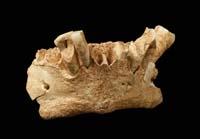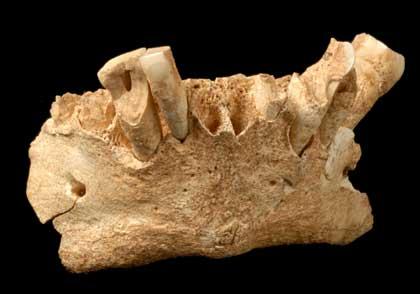H. sapiens
2008/10/11 Galarraga Aiestaran, Ana - Elhuyar Zientzia

Eudald Carbonell, Atapuerca. (Photo: J.M. Benito. Some rights reserved: CC, declare, share equally)
Recently we had the opportunity to hear a lecture by Eudald Carbonell on the Environment and Journalism in Cordoba. Specifically, at the International Seminar, where he pointed out that man continues to evolve. What's more, according to him, the path we take leads to disaster and a large part of the population disappears.
Scientists call this loss of population the "bottleneck" and refers to the descent that suffers a species due to a great tightening. This type of processes promote evolution and have a great influence on the evolution of a species. In fact, in the situation that causes the bottleneck, the characteristics that help to survive predominate, while those that are less favorable are reduced or lost. Therefore, the population that remains is different from the previous one.
The human species has passed several times through the narrow neck of the bottle, for example in the Middle Ages by the black plague. The Asian plague that emerged entered the Mediterranean ports and extended to the north of Europe, causing the death of a third of the European population between 1346-1353. It is estimated that about 25 million people died, much more than any other disease or war that existed until then.
In another continent, America, XVI. The largest massacre occurred in the twentieth century. The diseases carried out by the Europeans caused the decline of the population. Many researchers believe that smallpox and measles had more influence than weapons in the conquest of America. Thus, according to US researcher Dobyns, 95% of the population across America was lost during the first 130 years since their arrival in the continent of Columbus.
Well, in Carbonell's words, we now go towards a similar strait. In fact, at the end of the conference he made these statements, since the theme of the conference was another: New interpretations of the last hominid found in Atapuerca, since Carbonell and his team published in March in the scientific journal Nature an article on the fossil of the oldest hominid in Europe. It was discovered in the elephant cave and was called Homo antecessor.
It is estimated that the fossil has a minimum age of 1.2 million years and, in principle, it was proposed that it could be the last common predecessor of the Neanderthal man and of our species.
However, other hypotheses have now been studied, among which is the disappearance of the Homo antecessor without leaving offspring, that is, it was not the precedent of the Homo neanderthaliensis or of the Homo sapiens, but a species that arose in a time and disappeared without giving branches. And this is the most likely hypothesis for Carbonell. If this were so, the man H.antecessor would be an example that a species can disappear without leaving a trace.
Past, present, future

Deposit of Atapuerca. (Photo: M. M. Modest)
To understand the present and predict the future, it is essential to know the past. And Carbonell warns that such disappearances should be taken into account. He pointed out that one of the great drivers of the evolution of the human species is extinction, extinction. "We are the leaf of an almost rotten tree," he explained, "because there is no other species of the genus Homo, although in its day there were up to four. And if you are not aware of what this leaf represents which is our species and falls, that great evolutionary tree, the genus Homo, can fall by inactivity, by lack of energy."
He made these statements with a point of despair, but believes that in evolution we must go through this type of processes and for him now XXI. In the twentieth century the man passes through the neck of the bottle. And when this happens, the human being will have another level of consciousness. In fact, it considers it necessary to have this new awareness to extend the technology developed to society as a whole and use it for the benefit of the entire population.
In addition, Carbonell is clear that nothing can be done to avoid disaster, the mechanisms that have launched the process are already unstoppable. The archaeologist does not believe in “sustainable development”, for him development and sustainability are opposing concepts, since development is not sustainable at all. Therefore, regardless of what we do, our species will pass through the neck of the bottle.
However, other scientists do not think the same. Physicist and cosmologist Stephen Hawking, who participated in Cordoba during the days of celebration of this seminar, also made predictions about the human species in Santiago. In his opinion, the human being is now facing serious threats, such as climate change or the risk of a nuclear war, and the solution should be sought in space. That is, that outside the Earth we should migrate to another planet or satellite. But, can we get out before the disaster?
Published in Gara

Gai honi buruzko eduki gehiago
Elhuyarrek garatutako teknologia





